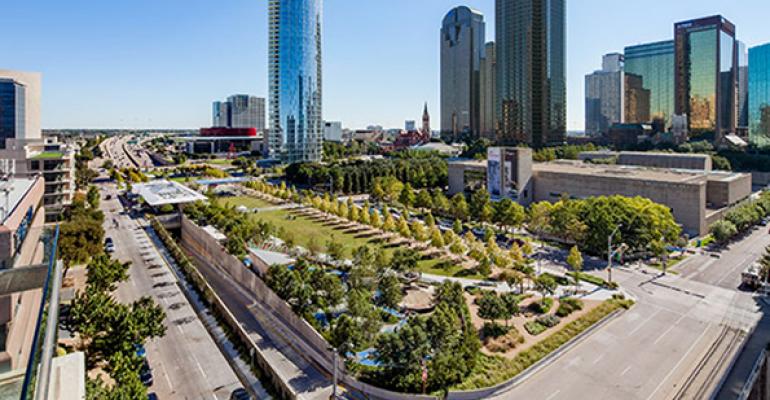This year there has been a lot of talk about the 125th anniversary of the opening of New York’s Carnegie Hall. Bequeathed to the city by famed industrialist Andrew Carnegie, it’s the most famous example of real estate philanthropy by the great industrialist, in a portfolio that included the creation of some 3,000 public libraries and the founding and support of several colleges.
While Carnegie’s philanthropy helped transform infrastructure (not to mention culture) in numerous cities, more modern examples of civic philanthropy are having their own profound impact on real estate. As investments, their “rates of return” are significant in legacy building, but they’re also contributing to urban livability, which, in turn, attracts upscale housing, retail and other infrastructure investments.
Make no mistake: Philanthropically driven infrastructure inspires economic development as a result of cultural enrichment. Consider some examples:
Klyde Warren Park is a public space in downtown Dallas that spans three city blocks and some 5.2 acres over a recessed freeway. Like so many of these new examples of real estate philanthropy, the park was funded partly by private funds, most notably by Texas billionaire Kelcy Warren, who contributed a reported $10 million to the project, which is now named for Warren’s son.
The park has inspired an enhanced commercial neighborhood around it, known today as the park district. As the “front lawn” of adjacent performing arts centers and art museums, it has created a vast open space more aesthetically pleasing than the typical urban plaza, and as a result—essential to our discussion—will add millions of dollars of property tax revenue to the city of Dallas. In addition, further development continues.
A similar example is the Rose Fitzgerald Kennedy Greenway, a one-mile-long linear park meandering through various Boston neighborhoods. While inspired by the late matriarch of the Massachusetts political dynasty, it’s funded half-and-half by a private conservancy and public funds. And while not personally funded by a single wealthy individual, in the Carnegie mold, the project was pushed forward by the late Senator Edward M. Kennedy. The private donations and stylized design would not have been possible without the famous connection with the Kennedy family, their wealthy friends and colleagues.
In fact, fame as much as money, seems to be a common thread in today’s real estate philanthropic investments. Consider the New York Restoration Project, founded by actress Bette Midler, active in planting trees and renovating gardens and parks throughout the city. It’s been promoted via the city’s Million Trees Initiative, also active in Los Angeles and Denver.
Midler’s commitment was in response to controversy surrounding what many felt was an excessive bottom-line focus on commercial development. In 1999, New York planned to auction more than 100 community gardens to make room for new office buildings. In response, Midler spurred the creation of New York’s Garden Trust, saved more than 50 green spaces and helped fund their renovation.
To see the results today, as trees and gardens bloom throughout the city, is to recognize that successful real estate investment depends as much on surrounding beauty and livability as on bottom-line rigor. In fact, they’re inextricable.
Another example of real estate philanthropy is the dramatically designed Crystal Bridges Museum of American Art in Bentonville, Ark., a visionary project of Alice Walton, of Walmart wealth, to the company’s home town. The Walton Family Foundation pitched in about $1.3 billion to fund the museum, including $137 million worth of art Alice helped select. Essentially, the museum has transformed the small town’s cultural landscape, increasing tourism to northwest Arkansas, and inspired new hotel development to support the increased visits.
Among the most prominent of current philanthropic projects to enhance quality of life is the “giving pledge” founded by Warren Buffet and Bill Gates, and joined by such billionaires as Microsoft co-founder Paul Allen, publisher Michael Bloomberg, Oracle’s Larry Ellison, investor Carl Icahn, Tesla’s Elon Musk and many others, who have pledged to donate much of their wealth in support of “game-changing gifts” to America’s communities.
With a combined wealth of almost $1 trillion, the individuals signed on to the giving pledge may make as significant a difference to our cities’ infrastructure and quality of life as did Andrew Carnegie many years ago.
R. Byron Carlock Jr. is a principal and the national real estate practice leader at PricewaterhouseCoopers. He can be reached at [email protected].





